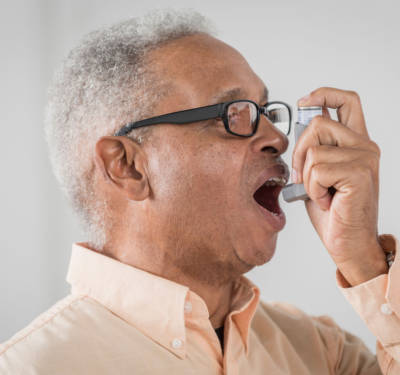Promising approaches for controlled pulmonary drug delivery
Can particulate-based delivery systems cancel barriers to therapeutic effectiveness of inhaled drugs?
Published online 29 May 2015

Inhalers are becoming an important drug delivery system for various diseases.
© Blend Images / Alamy
The limitations of inhalation therapies have led scientists to come up with micro- and nanoparticles-based drug delivery systems that a new review scrutinizes.
Inhalers are widely used to treat respiratory diseases such as asthma, but their cellular mechanisms sometimes clear inhaled medications from the lungs quickly to ensure sterility of the lungs. In the process, the drugs’ bioavailability is reduced.
A new review by Ibrahim El-Sherbiny of Zewail City of Science and Technology, Egypt, and his colleagues summarizes the lung’s multiple clearance mechanisms, and discusses the innovative approaches being used to optimize pulmonary delivery of drugs1.
The main defence mechanism operating in the lungs is mucocilliary clearance, which occurs in the upper respiratory tract. Here, specialized cells trap foreign particulate matter within mucus, then use their hair-like appendages to move it downwards so it can be expelled by coughing or sneezing.
Immune cells called alveolar macrophages are found deep inside the lungs. They provide an additional line of defence by engulfing foreign particles that entre. Inhaled drugs are also degraded by enzymes in the lungs, and absorbed rapidly owing to the lungs’ large surface area.
Micro- and nanoparticles-based drug delivery systems could potentially improve the delivery of inhaled drugs significantly, because they can be designed in specific shapes and sizes, and with certain other properties that optimize their bioavailability.
The authors looked at advances in lung drug delivery systems including liposomes, solid–lipid nanoparticles, micelles and cyclodextrins.
One approach uses spherical particles called liposomes, made of natural or synthetic fatty acid molecules. Liposomes encapsulate the drug molecules, preventing enzymatic degradation and enhancing half-life and availability.
Solid–lipid nanoparticles are smaller than liposomes, but also consist of fatty acid molecules and work in the same way. They, too, enhance the bioavailability of delivered drugs, and also prolong their therapeutic effects. Similarly, nano- and microparticles made of natural or synthetic polymers increase bioavailability and, being biocompatible, they also minimize toxicity.
Micelles are aggregates of detergent-like molecules that assemble themselves into spherical nanostructures in solution. They improve drug stability, can be tailored to target specific tissues, and allow for slow and sustained drug release.
Cyclodextrins consisting of polymeric sugar molecules are commonly used because they pass through biological barriers without affecting their integrity, and carry larger quantities of drugs, which are absorbed rapidly.
“These delivery systems have yet to come to fruition,” says El-Sherbiny. “Much research needs to be done in order to enhance them [and] deliver drugs efficiently to treat not only lung diseases but also diseases in [other parts of] the body.”
Reference
- El-Sherbiny, I. M., El-Baz, N. M. & Yacoub, M. H. Inhaled nano- and microparticles for drug delivery. Glob. Cardiol. Sci. Pract. 2015, 2 (2015). | article
DOI: 10.1038/qsh.2015.63

